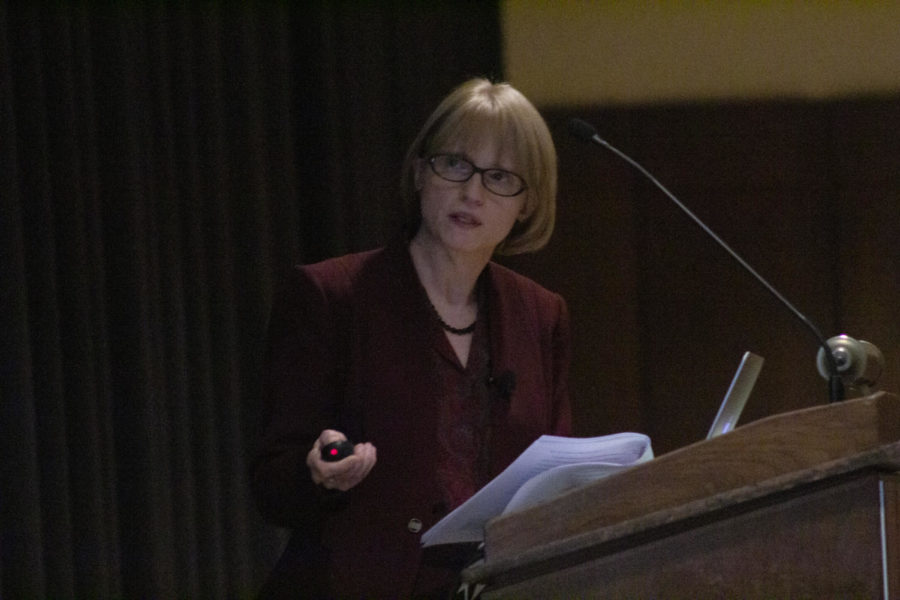Professor shares research on intersection of medieval architecture, religion and design
Kennedy DeRaedt/Iowa State Daily
Associate professor in the College of Arts and Sciences at Vanderbilt University, Tracy Miller, speaks on the history of art and architecture in Asia during the “Rethinking Creativity: Generative Design in the Architecture of Medieval Chinese Buddhism” lecture. The 2019 Donald R. Benson Memorial Lecture was held in the Sun Room of the Memorial Union on April 23.
April 23, 2019
Tracy Miller, associate professor in the College of Arts and Sciences at Vanderbilt University, spoke Tuesday in the Sun Room in the Memorial Union.
Titled “Rethinking Creativity: Generative Design in the Architecture of Medieval Chinese Buddhism,” the lecture provided an in-depth look into the complex relationship between art, architecture and religion.
“I will be talking about medieval temple architecture and looking at it from a design perspective,” Miller said. “Design in this context results from the ability of the artisan to actualize the aesthetic preferences of the patron.”
Miller’s lecture detailed commonalities between structures spread throughout Asia thousands of years ago. She also spoke about the magical properties of these structures and the beliefs the people had at the time in East Asia.
One of these structures is the pagoda, a Buddhist temple, located at the Songyue Monastery built during the Northern Wei dynasty. This pagoda is known as the oldest Chinese brick pagoda.
“The unusual form and unusual history of the Songyue Monastery pagoda suggests that this structure may have been designed to take advantage of new technology imported with Buddhism to better harness the powers of terrestrial and celestial spheres,” Miller said.
Miller also spoke about talismans, which are objects believed to hold magical properties that bring good luck to the possessor or protect the possessor from evil or harm.
“[Those who possess a talisman] will not have evil dreams and their heavy transgressions of previous lives will be eliminated,” Miller said.
Miller spoke extensively about a grid system used in medieval architecture. The grid helped form what were thought to be magical patterns, and could be used to explain the similarities in structures that were located so far away from each other.
Michael Schell, senior in interior design, was one of the students attending the lecture.
“I thought the idea that everything was based on a grid system was cool,” Schell said. “I’m not sure if I buy it but maybe it was a coincidence.”
Michael Kinley, senior in finance, also attended the lecture Tuesday.
“It was really interesting to see the breakdown of the use of basic geometric figures in the more complex architecture,” Kinley said.
Miller is the author of “The Divine Nature of Power: Chinese Ritual Architecture at the Sacred Site of Jinci” and is currently working on another book detailing the use of Indic design strategies in the Buddhist temple architecture of Early Medieval and Medieval China.
Miller teaches at Vanderbilt in the history of art and architecture in Asia, with an emphasis on the ritual and garden architecture of Imperial China and Japan. She holds a doctorate from the University of Pennsylvania in East Asian Art and Architecture.







